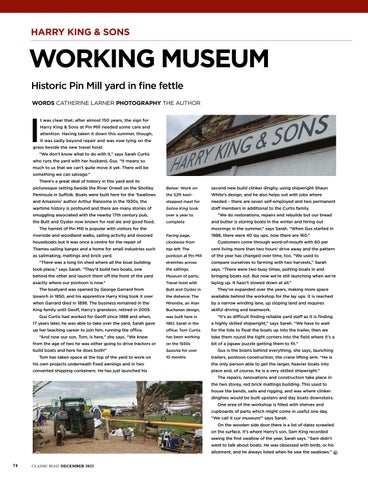CRAFTSMANSHIP
HARRY KING & SONS
WORKING MUSEUM Historic Pin Mill yard in fine fettle WORDS CATHERINE LARNER PHOTOGRAPHY THE AUTHOR
I
t was clear that, after almost 150 years, the sign for Harry King & Sons at Pin Mill needed some care and attention. Having taken it down this summer, though, it was sadly beyond repair and was now lying on the
grass beside the new travel hoist. “We don’t know what to do with it,” says Sarah Curtis who runs the yard with her husband, Gus. “It means so much to us that we can’t quite move it yet. There will be something we can salvage.” There’s a great deal of history in this yard and its picturesque setting beside the River Orwell on the Shotley
Below: Work on
second new build clinker dinghy, using shipwright Shaun
Peninsula in Suffolk. Boats were built here for the ‘Swallows
the 52ft keel-
White’s design, and he also helps out with jobs where
and Amazons’ author Arthur Ransome in the 1930s, the
stepped mast for
needed – there are seven self-employed and two permanent
wartime history is profound and there are many stories of
Selina King took
staff members in additional to the Curtis family.
smuggling associated with the nearby 17th century pub,
over a year to
the Butt and Oyster now known for real ale and good food.
complete
The hamlet of Pin Mill is popular with visitors for the
“We do restorations, repairs and rebuilds but our bread and butter is storing boats in the winter and hiring out moorings in the summer,” says Sarah. “When Gus started in
riverside and woodland walks, sailing activity and moored
Facing page,
houseboats but it was once a centre for the repair of
clockwise from
Thames sailing barges and a home for small industries such
top left: The
cent living more than two hours’ drive away and the pattern
as sailmaking, maltings and brick yard.
pontoon at Pin Mill
of the year has changed over time, too. “We used to
stretches across
compare ourselves to farming with two harvests,” Sarah
took place,” says Sarah. “They’d build two boats, one
the saltings;
says. “There were two busy times, putting boats in and
behind the other and launch them off the front of the yard
Museum of parts;
bringing boats out. But now we’re still launching when we’re
exactly where our pontoon is now.”
Travel hoist with
laying up. It hasn’t slowed down at all.”
“There was a long tin shed where all the boat building
The boatyard was opened by George Garrard from
1988, there were 40 lay ups, now there are 160.” Customers come through word-of-mouth with 60 per
Butt and Oyster in
They’ve expanded over the years, making more space
Ipswich in 1850, and his apprentice Harry King took it over
the distance; The
available behind the workshop for the lay ups. It is reached
when Garrard died in 1898. The business remained in the
Mirembe, an Alan
by a narrow winding lane, up sloping land and requires
King family until Geoff, Harry’s grandson, retired in 2005.
Buchanan design,
skilful driving and teamwork.
Gus Curtis had worked for Geoff since 1988 and when,
was built here in
17 years later, he was able to take over the yard, Sarah gave
1961; Sarah in the
a highly skilled shipwright,” says Sarah. “We have to wait
up her teaching career to join him, running the office.
office; Tom Curtis
for the tide to float the boats up into the trailer, then we
has been working
take them round the tight corners into the field where it’s a
from the age of two he was either going to drive tractors or
on the 1930s
bit of a jigsaw puzzle getting them to fit.”
build boats and here he does both!”
Saxonia for over
“And now our son, Tom, is here,” she says. “We knew
Tom has taken space at the top of the yard to work on
10 months
“It’s as difficult finding reliable yard staff as it is finding
Gus is the brains behind everything, she says, launching trailers, pontoon construction, the crane lifting arm. “He is
his own projects underneath fixed awnings and in two
the only person able to get the larger, heavier boats into
converted shipping containers. He has just launched his
place and, of course, he is a very skilled shipwright.” The repairs, renovations and construction take place in the two storey, red brick maltings building. This used to house the bends, sails and rigging, and was where clinker dinghies would be built upstairs and day boats downstairs. One area of the workshop is filled with shelves and cupboards of parts which might come in useful one day. “We call it our museum!” says Sarah. On the wooden side door there is a list of dates scrawled on the surface. It’s where Harry’s son, Sam King recorded seeing the first swallow of the year, Sarah says. “Sam didn’t want to talk about boats. He was obsessed with birds, or his allotment, and he always listed when he saw the swallows.”
74
CLASSIC BOAT DECEMBER 2022







